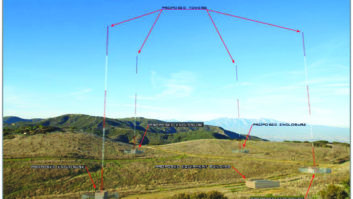The Nems-Clarke 120 and RCA WX-2 Field Intensity Meters (FIMs) use five common 1.5V D-cells for filaments (four for the receiver, one for the calibrating oscillator) and two 67.5V NEDA 200 (Eveready #467) “B” batteries for plate power (one for the receiver, one for the calibrating oscillator).
This article describes how to convert these meters to use common 9V batteries instead of the more expensive and harder-to-get 67.5V batteries. Each “B” battery will be replaced by a series string of seven 9V batteries.

Batteries in an RCA WX-2A Field Intensity Meter. The WX-2C and WX-2D meters don’t have the hold-down clamps or fiber spacers.
The negative terminal of the calibrating oscillator’s “B” battery is grounded. The receiver’s “B” supply also develops bias voltage inside the FIM. For this reason, the receiver battery’s negative terminal is not grounded, so you need two isolated power sources.
It’s likely that the FIMs will operate properly on 72 volts (eight 9V batteries in series) however I didn’t want to push my luck, and they work great with the nominal 63 volts.
The economics
The #467 batteries are rated for 67.5V at 550 mAh. They’re constructed of 45 1.5V cells connected in series. End-of-life is 0.8 volts per cell (a total battery voltage of 36 volts). These batteries cost $30–$50 each. Some suppliers offer free shipping, so check around.
Common 9V alkaline batteries are rated for 9V at 625 mAh. They’re constructed of six 1.5V cells connected in series. End-of-life is 0.8 volts per cell (a total battery voltage of 4.8 volts). Seven batteries in series will provide a nominal 63 volts and will be good for many hundreds of measurements. You can buy these for as low as $1.50 each.
The one-time cost to convert the meter is about $10 plus half an hour’s time. A full set of 14 batteries can be bought for as little as $21, much less than $60 or more for the stock “B” batteries, and if you’re out in the field and the batteries die, you can buy new ones anywhere. Shelf life is about the same too.
Parts required:
- 14 9V battery connectors with leads, Mouser part number 123-5114-GR. These cost $0.60 each in 2011. I used these because they are constructed of hard plastic rather than just a soft vinyl covering. This makes them much easier to attach and detach from the batteries.
- 14 9V alkaline batteries, commonly referred to as NEDA 1604 or 1604A. These can be bought in bulk (industrial packages) on popular auction sites.
- One foot of 1/16 inch ID (size before shrinkage) heat-shrink tubing, cut into 12 one-inch long pieces.
Construction
The battery connectors have four-inch-long red and black wires permanently attached. Slide a piece of heat-shrink tubing over one red wire and twist and solder it to the black wire of another connector. Fold the soldered joint over and slide the heat-shrink tubing over the splice. Build a string of seven connectors (six splices) in series. Try to arrange the entire assembly as a string that looks like a long “W”. You should have one red wire at one end and one black wire at the other end remaining. Shrink all the tubing when you’re done.
Installation
You might as well remove the D-cells, clean the screw terminals with a brass wire brush, and install new alkaline batteries while you’ve got the compartment open.
Remove any existing “B” batteries from the FIM. Identify the unit’s battery terminals and keep them paired correctly (my WX-2A had four loose battery wires and terminals while the others had two pairs of wires and terminals held together with fish paper). The positive terminal of the original BATTERY is the smaller (male) contact, so the positive terminal of the meter wiring HARNESS is the larger split (female) contact. Attach the red wire from one 9V battery string to the positive harness contact by soldering it to the rivet in the center. This way you can still use original batteries if you ever want to by just unsoldering the little wire. Similarly, solder the black wire from the 9V battery string to the negative harness contact. Wrap the FIM’s battery contacts with electrical tape. Repeat this procedure for the other pack.
Using electrical or masking tape, build six pairs of 9V batteries with the terminals all oriented the same way but leave two batteries separate. Each string uses seven batteries: three of the taped pairs and one single battery. Untangle the string of connectors and attach them to the batteries. Be careful not to short anything out, especially to the chassis. Do this for both strings.
There is sufficient room inside the battery compartment for all these batteries where the “B” batteries were. Lay the meter face down with the battery compartment fully open, then place pairs of batteries inside with the wired connectors facing the top, ending with the single battery along the top above the others. The FIM’s battery terminals can be stuffed above everything else. Squish the wires down so they won’t be pinched when you close the battery compartment. I didn’t need to add foam or other packing material to keep the batteries from moving. Shut and latch the battery compartment, check the four battery voltages on the meter for an appropriate reading, and you’re done.
The photo shows the batteries in an RCA WX-2A Field Intensity Meter. The WX-2C and WX-2D meters don’t have the hold-down clamps or fiber spacers. Put electrical tape over the hold-down clamps to prevent the exposed sides of the battery terminals from shorting out to them (I learned this from actual experience one day and was surprised when one 9V battery actually sizzled and blew apart).
Operation
With only 63 volts instead of the 67.5V, the battery voltage indications on the FIM will be slightly lower than what you might be used to. The FIMs are rated to operate with 50–70 volts, so you should still have plenty of useful life with the new 9V batteries. When each 9V battery drops to 7 volts, you’ll be at 49 volts total and they should all be replaced.
To date I’ve performed this modification on an RCA WX-2D, an RCA WX-2C and an RCA WX-2A. The Nems-Clarke 120E essentially is identical to the RCA WX-2D and should be just as easy. Even after six months of exhaustive use repairing and testing these meters, there’s still plenty of life remaining in the batteries.
Do you like this kind of article? Let Radio World know at [email protected].
Robert W. Meister is an amateur radio operator (WA1MIK) and FCC licensed contract radio engineer in Southern Connecticut. He can be reached via e-mail at his callsign [ at ] comcast [ dot ] net.












